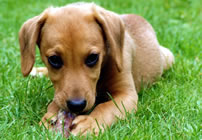
Food and non-food items that can be hazardous to your dog’s health
Most dog owners have heard their share of warnings about certain foods that can make their dog ill or result in death when ingested in a large enough quantity. Some of the more common toxic foods that dog owners are generally aware of include:
- Bones – pose a choking risk or can become lodged in the digestive tract
- Chocolate – toxic levels possible with the ingestion of 1 ounce per 1 pound of body weight for milk chocolate, 1 ounce per 3 pounds of body weight for semi-sweet chocolate, and 1 ounce per 9 pounds of body weight for baker’s chocolate
- Onions – can lead to a severe case of hemolytic anemia whereby the blood doesn’t carry enough oxygen to all parts of the dog’sb ody
- Raw eggs – can cause salmonella poisoning
- Raw meat – can cause salmonella and/or clostridium poisoning (even though there’s a growing number of dog owners who rely on a raw food diet for their dog)
As a responsible and concerned dog owner, there are a number of other foods that you should be aware of that pose a potential health risk to your furry friend. Such items include:
- Grapes – can lead to kidney damage and death if consumed in a large enough quantity
- Green parts of potatoes and tomatoes – can cause problems for numerous body systems
- Macadamia nuts – can negatively affect multiple systems due to an as-yet-unidentified substance
- Raisins – same as grapes
- Rawhide “treats” – can be a choking hazard, can be contaminated with salmonella poisoning, and many are treated with a variety of potentially harmful chemicals
- Sugarless candy and other items that contain xylitol – can cause liver damage and death
- Uncooked bread dough – can swell in the stomach and cause discomfort and/or blockages
- Walnuts – particularly the seed hulls of black walnuts as they can cause stomach problems and moldy ones can cause seizures
Dog owners should also be familiar with non-food items that are commonly available in their environment and that can be hazardous when ingested. These items include:
- Automatic dish detergents
- Batteries
- Cocoa bean mulch
- Coffee grounds
- Fabric-softener sheets
- Grass that has recently been treated with chemicals
- Human medications such as antidepressants, cold formulas, diet pills, pain killers (including aspirin and ibuprofen), and vitamins
- Mothballs
- Numerous houseplants and/or plants found in the landscape (refer to www.aspca.org/site/FrameSet?style=User&url=http://www.aspca.org/toxicplants/M01947.htm or www.ansci.cornell.edu/plants/doglist.html for lists of plant-specific symptoms and plant identification photos)
- Potpourri
- Tobacco products
One other commonly overlooked area related to the safety of the food that your dog eats is his or her food and/or water bowls. Make sure that the ones your dog is using aren’t contaminated with lead or any other hazardous compounds that might slowly leach out.
The Animal Poison Control Center of the American Society for the Prevention of Cruelty to Animals has extremely valuable and current informational reports available online that pertain to newly identified hazardous foods and non-food items that your pet might encounter (www.aspca.org). Refer to their web site to help you do your homework both inside and outside your home to identify, remove, and/or properly store potential “food” risks to your dog. The health of your canine companion depends on it.

